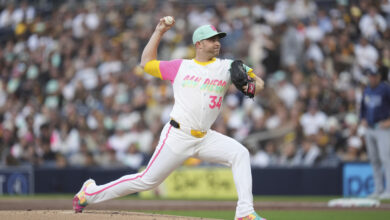Is Jorge Soler the Tipping Point for the Cubs?
The tipping point is coming for this team.
Cubs fans find themselves in the middle of a crashing wave, but Jorge Soler is more than just another guy that we’ve heard about for years. Soler represents a change in the rebuild on a number of different levels.
Offense has been a problem for the Chicago Cubs for a long time. In the past decade the Cubs have been in the top half of offense by wRC+ just twice, and the last time was the 2008. The offensive woes reached their peak in the first year of the new regime.
The Cubs finished last in the NL that season with an 81 wRC+. The Cubs have seen modest improvements the past two seasons, with totals of 88 and 87 respectively. Their ranking in the NL even improved from 14th to 11th despite the one-point drop.
Soler now represents the fifth long-term piece added to the lineup. That is a presumptuous label, but the Cubs have five future everyday players in their lineup for the first time in this regime. The benefit to the team, beyond the obvious talent improvement, is the increased flexibility the roster offers. The positional flexibility of the starters allows for the bench to be more specialized, and provides value at the margins in ways that the platoon roster could not.
The offensive doldrums the Cubs have faced have resulted in a dramatic lack of power. Home runs are down throughout the game, but the Cubs’ top 5 home run seasons under Theo Epstein are as follows: ’12 Soriano (32), ’14 Rizzo (30), ’13 Rizzo (23), ’13 Schierholtz (21), and ’13 Soriano (17). Soler, along with Baez, provides the Cubs another legitimate 30-home-run threat alongside Anthony Rizzo.
The players the Cubs had previously been counting on to provide that level of power were the likes of Mike Olt and, well, I am not sure there was anyone else after the Cubs traded the corpse of Alfonso Soriano.
The stress placed on the opposition by the power these hitters provide is an effect that is hard to measure, but not all pitches are created equal. The Cubs staff has managed to keep the team close this year, so it figures that having so many hitters capable of changing the game with one swing would result in a lot of high-stress pitches for the opposition. This, along with taking pitches, could allow the offense to be even better than the just what the raw talent of these young hitters allows for.
The reason Soler might be the tipping point in this rebuild is that he is the second guy acquired by this front office to make his debut. All the other call-ups so far, outside of Rizzo, have been players initially acquired by Jim Hendry. A look at the team’s current BB% reveals that fact pretty clearly.
Theo Epstein and Jed Hoyer have acquired seven players who have walk rates over 7% this year. The highest Hendry-era acquisition in that category is Matt Szczur, who has 6.7%, though, admittedly, that’s in only 15 plate appearances. Arismendy Alcantara, the first Hendry guy with more than 100 PA, checks in at 6.4%. Soler gives the Cubs another patient slugger in the heart of the order to pair with Anthony Rizzo.
The Cubs don’t have to build a team full of Mark Bellhorn three-true-outcome sluggers (I mean, I wouldn’t be opposed to that play either).
But the addition of another guy capable of commanding the strike zone has a cumulative effect on the roster. It drives pitch counts up and increases the number of at-bats a team has against the opposition’s weakest pitchers. This is the formula that the greatest offensive Cubs team of this millennium used to perfection.
The only guarantee at this point is that nothing is certain for this franchise moving forward. The three crown jewels of the system called up this season could all fail, but there is a critical mass that is being achieved at this moment. Soler might be the guy that pushes this team to a non-linear jump in progress. After all, the Cubs are due for some positive progression.

